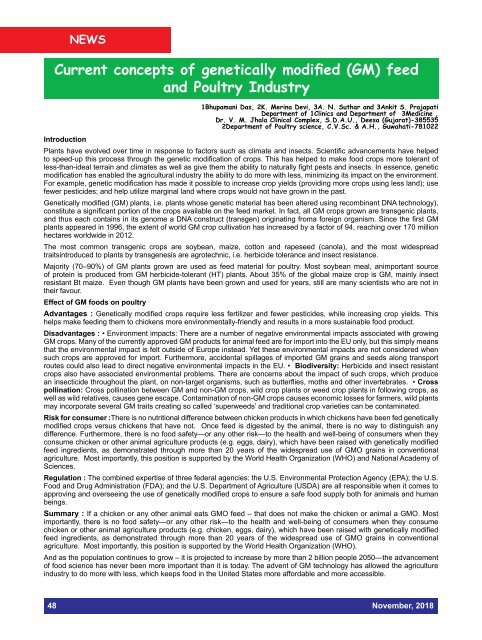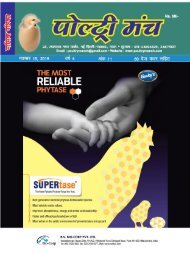November 2018 Punch PDF
You also want an ePaper? Increase the reach of your titles
YUMPU automatically turns print PDFs into web optimized ePapers that Google loves.
NEWS<br />
Current concepts of genetically modified (GM) feed<br />
and Poultry Industry<br />
1Bhupamani Das, 2K. Merina Devi, 3A. N. Suthar and 3Ankit S. Prajapati<br />
Department of 1Clinics and Department of 3Medicine ,<br />
Dr. V. M. Jhala Clinical Complex, S.D.A.U., Deesa (Gujarat)-385535<br />
2Department of Poultry science, C.V.Sc. & A.H., Guwahati-781022<br />
Introduction<br />
Plants have evolved over time in response to factors such as climate and insects. Scientific advancements have helped<br />
to speed-up this process through the genetic modification of crops. This has helped to make food crops more tolerant of<br />
less-than-ideal terrain and climates as well as give them the ability to naturally fight pests and insects. In essence, genetic<br />
modification has enabled the agricultural industry the ability to do more with less, minimizing its impact on the environment.<br />
For example, genetic modification has made it possible to increase crop yields (providing more crops using less land); use<br />
fewer pesticides; and help utilize marginal land where crops would not have grown in the past.<br />
Genetically modified (GM) plants, i.e. plants whose genetic material has been altered using recombinant DNA technology),<br />
constitute a significant portion of the crops available on the feed market. In fact, all GM crops grown are transgenic plants,<br />
and thus each contains in its genome a DNA construct (transgen) originating froma foreign organism. Since the first GM<br />
plants appeared in 1996, the extent of world GM crop cultivation has increased by a factor of 94, reaching over 170 million<br />
hectares worldwide in 2012.<br />
The most common transgenic crops are soybean, maize, cotton and rapeseed (canola), and the most widespread<br />
traitsintroduced to plants by transgenesis are agrotechnic, i.e. herbicide tolerance and insect resistance.<br />
Majority (70–90%) of GM plants grown are used as feed material for poultry. Most soybean meal, animportant source<br />
of protein is produced from GM herbicide-tolerant (HT) plants. About 35% of the global maize crop is GM, mainly insect<br />
resistant Bt maize. Even though GM plants have been grown and used for years, still are many scientists who are not in<br />
their favour.<br />
Effect of GM foods on poultry<br />
Advantages : Genetically modified crops require less fertilizer and fewer pesticides, while increasing crop yields. This<br />
helps make feeding them to chickens more environmentally-friendly and results in a more sustainable food product.<br />
Disadvantages : • Environment impacts: There are a number of negative environmental impacts associated with growing<br />
GM crops. Many of the currently approved GM products for animal feed are for import into the EU only, but this simply means<br />
that the environmental impact is felt outside of Europe instead. Yet these environmental impacts are not considered when<br />
such crops are approved for import. Furthermore, accidental spillages of imported GM grains and seeds along transport<br />
routes could also lead to direct negative environmental impacts in the EU. • Biodiversity: Herbicide and insect resistant<br />
crops also have associated environmental problems. There are concerns about the impact of such crops, which produce<br />
an insecticide throughout the plant, on non-target organisms, such as butterflies, moths and other invertebrates. • Cross<br />
pollination: Cross pollination between GM and non-GM crops, wild crop plants or weed crop plants in following crops, as<br />
well as wild relatives, causes gene escape. Contamination of non-GM crops causes economic losses for farmers, wild plants<br />
may incorporate several GM traits creating so called ‘superweeds’ and traditional crop varieties can be contaminated.<br />
Risk for consumer :There is no nutritional difference between chicken products in which chickens have been fed genetically<br />
modified crops versus chickens that have not. Once feed is digested by the animal, there is no way to distinguish any<br />
difference. Furthermore, there is no food safety—or any other risk—to the health and well-being of consumers when they<br />
consume chicken or other animal agriculture products (e.g. eggs, dairy), which have been raised with genetically modified<br />
feed ingredients, as demonstrated through more than 20 years of the widespread use of GMO grains in conventional<br />
agriculture. Most importantly, this position is supported by the World Health Organization (WHO) and National Academy of<br />
Sciences.<br />
Regulation : The combined expertise of three federal agencies: the U.S. Environmental Protection Agency (EPA); the U.S.<br />
Food and Drug Administration (FDA); and the U.S. Department of Agriculture (USDA) are all responsible when it comes to<br />
approving and overseeing the use of genetically modified crops to ensure a safe food supply both for animals and human<br />
beings.<br />
Summary : If a chicken or any other animal eats GMO feed – that does not make the chicken or animal a GMO. Most<br />
importantly, there is no food safety—or any other risk—to the health and well-being of consumers when they consume<br />
chicken or other animal agriculture products (e.g. chicken, eggs, dairy), which have been raised with genetically modified<br />
feed ingredients, as demonstrated through more than 20 years of the widespread use of GMO grains in conventional<br />
agriculture. Most importantly, this position is supported by the World Health Organization (WHO).<br />
And as the population continues to grow – it is projected to increase by more than 2 billion people 2050—the advancement<br />
of food science has never been more important than it is today. The advent of GM technology has allowed the agriculture<br />
industry to do more with less, which keeps food in the United States more affordable and more accessible.<br />
48 <strong>November</strong>, <strong>2018</strong>





